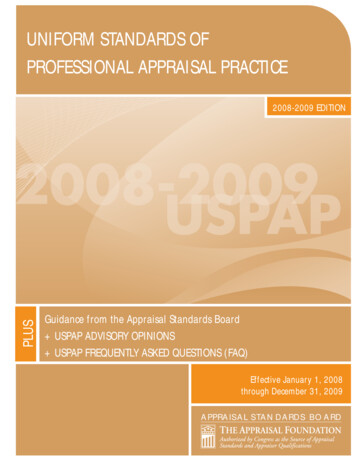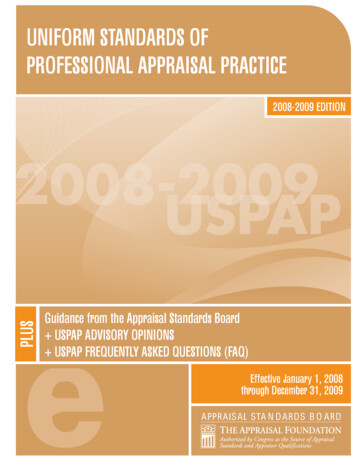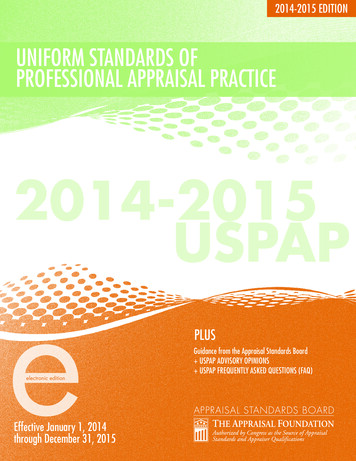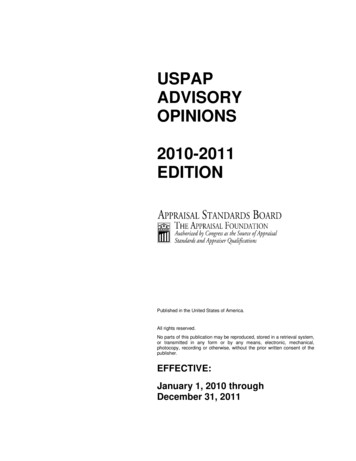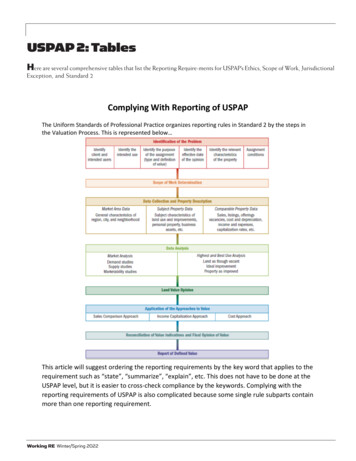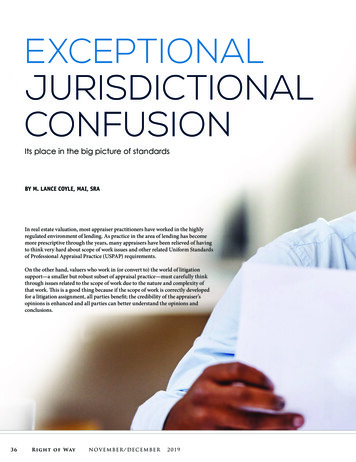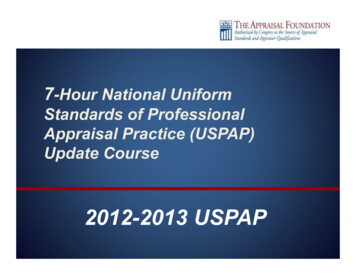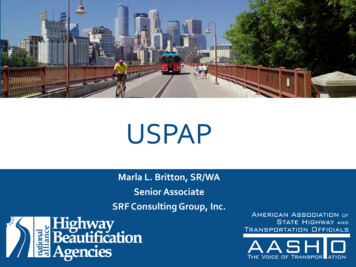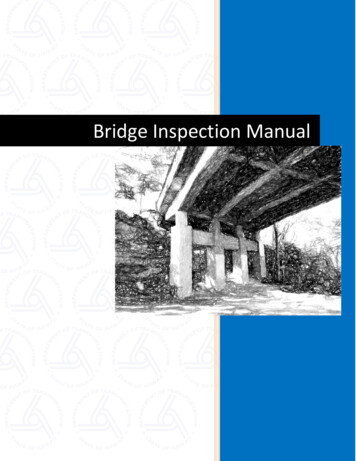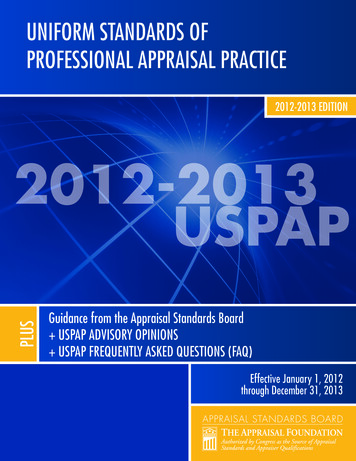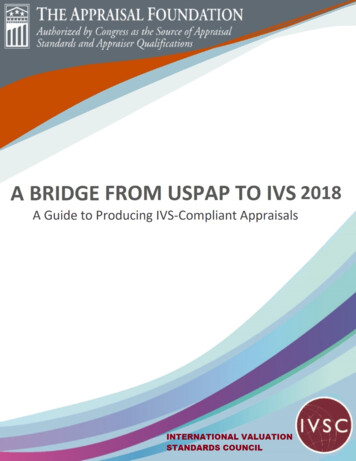
Transcription
A Bridge from USPAP to IVS 2018A Guide to Producing IVS-Compliant AppraisalsExecutive SummaryIf compliance with the International Valuation Standards is appropriate or required for a specificassignment, appraisers who are accustomed to providing USPAP-compliant appraisals are a stepahead. This document describes additional steps to be taken by appraisers already accustomedto providing USPAP-compliant appraisals to make valuations IVS-compliant. Importantly, theprocess begins at the outset of the assignment by providing a scope of work document to theclient (appraisals, once communicated to the client/intended users, cannot be made IVScompliant retroactively.) Necessary scope of work components vary based on the item beingvalued and the intended use of the assignment results. This document has been updated toreflect revised editions of IVS and USPAP.IntroductionInternational Valuation Standards (IVS) – The IVS are valuation standards for assets andliabilities on a global basis. The IVS are published by the International Valuation Standards Council(IVSC), who began publishing international standards in the 1990’s. IVSC does not requirecompliance with IVS. Compliance is a matter of choice, agreement or regulation by anotherauthority. The use of the IVS continues to grow as the global economy becomes increasinglyinterconnected. The International Valuation Standards can be obtained at www.ivsc.org.Uniform Standards of Professional Appraisal Practice (USPAP) – USPAP are valuationstandards for assets and liabilities. While not necessarily limited to the United States, USPAP arenot created as international standards. USPAP is published by The Appraisal Foundation (TAF),who began publishing USPAP in 1989. TAF does not require compliance with USPAP. USPAPcompliance is a matter of choice, agreement or regulation by another authority. Also, TAF doesnot require compliance with IVS. USPAP can be obtained at www.appraisalfoundation.org.As the use of the International Valuation Standards grows, there will be both an increasing needfor appraisers to meet the requirements and increasing opportunities for those appraisers ableto do so. Fortunately, for appraisers already accustomed to USPAP, the two standards are quitesimilar.More Similar than DifferentRecognizing that public trust in the Valuation Profession is enhanced by having a common set ofvaluation standards, The Appraisal Foundation and the International Valuation Standards Councilhave been collaborating in the development of standards for years.A Bridge from USPAP to IVS 2018, January 1, 2018 - P a g e 1All Rights Reserved 2018 The Appraisal Foundation and the International Valuation Standards Council
Many differences in the standards are superficial and are due to different presentation andorganization. Some differences are unavoidable because the IVS have to be applicable across theglobe, whereas USPAP is designed for use within the United States and has to reflect U.S. law andpractice.In the end, both are remarkably similar. Both address the development of a valuation opinionbased on an appropriate scope of work. Both address report content and file documentation.Both address the competency and independence of the appraiser. As a result, an appraiseraccustomed to providing USPAP-compliant appraisal reports should not have much difficulty inalso meeting the requirements of the International Valuation Standards.Numerous, detailed, side by side comparisons have been created over the years by bothorganizations. Such detailed comparisons are academically interesting, but do not provide a clearanswer to the appraiser of “what do I need to do?”Which USPAP/Which IVS?This guide was created considering the requirements of the current IVS 2017 edition, whichbecame effective July 1, 2017, and the requirements of the 2018/19 edition of USPAP, whichbecame effective January 1, 2018.What is addressed in this Guide?USPAP has some requirements that do not appear in the IVS, and vice versa. It is the continuingview of the Standards Boards of both organizations that none of the additional requirements inUSPAP conflict with the IVS and therefore do not present a barrier to compliance. So, when avaluation needs to be compliant with IVS, by following USPAP standards, compliance with IVS iswell within reach. This guide therefore focuses on requirements in the IVS that do not appear inUSPAP.What is not addressed in this Guide?This guide does not focus on all the areas issues in which IVS and USPAP have effectively the samerequirements, nor issues in which USPAP has an additional requirement. Some critical aspects,such as work files, are discussed to acknowledge these areas have been considered.This guide does not discuss any topics that the IVS covers but are not currently addressed byUSPAP.IVS StructureIVS includes a Glossary, Framework, five general standards (IVS 101, 102, 103, 104 and 105) thatapply to all assignments, and six asset standards (IVS 200, 210, 300, 400, 410 and 500) that applydepending upon the type of asset being valued.A Bridge from USPAP to IVS 2018, January 1, 2018 - P a g e 2All Rights Reserved 2018 The Appraisal Foundation and the International Valuation Standards Council
IVS GlossaryBoth standards include a glossary or definitions section. USPAP contains a Definitions sectioncovering 36 terms whereas IVS contain a Glossary currently addressing 14 terms. Both standardsdifferentiate obligations on appraisers by intentional use of: “must,” “should” and “may.” Theseverbs are defined in the IVS glossary. The IVS glossary also defines “significant” and/or “material.”Aspects of valuation are considered significant if their application or impact on the valuationcould influence the economic or other decisions of users of the valuation. In IVS, the term“valuer” is used rather than “appraiser.” Also, in the IVS glossary, a valuer can be an individual, agroup of individuals or a firm, whereas in USPAP an appraiser is always an individual.IVS FrameworkThe IVS contain a framework that includes over-arching requirements for all valuations such asvaluer objectivity and competence. The Framework also addresses departure, which will bediscussed further in this document.USPAP includes an Ethics Rule that addresses an appraiser’s conduct, contingency fees orcommissions paid and confidentiality. The IVS Framework states that it is a fundamentalexpectation that when applying the standards there are appropriate controls in place to ensureobjectivity and freedom from bias, and that the valuer is competent. The IVSC has published theCode of Ethical Principles for Professional Valuers (the Code) and is a member of the InternationalEthics Standards Coalition (www.ies coalition.org). This Code is intentionally and necessarilyseparate from the International Valuation Standards reflecting the fact that the IVS are designedto be adopted and used by organizations working under different ethical codes throughout theworld. These necessarily differ in detail because of differences in the way the appraisal professionis regulated. An appraiser complying with the USPAP Ethics Rule will comply with theFundamental Principles of the IVSC Code of Ethical Principles for Professional Valuers.CompetencyBoth standards require that the appraiser be competent. USPAP permits an appraiser to acquirecompetency by either association with or retention of others reasonably believed to becompetent, or by personal study. The requirements in IVS only permit the appraiser to seekassistance from others. Therefore, when undertaking an IVS assignment there is a higher need toassociate with other appraisers to achieve competency. Such association must be disclosed inthe IVS Scope of Work and in the report.In IVS, the appraiser must have the technical skills, experience, and working knowledge tounderstand, interpret, and utilize the work of any specialists.USPAP Jurisdictional Exception IVS DepartureA jurisdictional exception in USPAP is considered a departure in the IVS. Note that USPAP doesnot require use of the term jurisdictional exception (JE). The two standards are very similarregarding what can create a JE and both require disclosure in the report of what part of thestandard was not followed due to the JE/Departure. In IVS, the departure must also be identifiedin the Scope of Work. USPAP is more restrictive in that the appraiser is to cite in the report theA Bridge from USPAP to IVS 2018, January 1, 2018 - P a g e 3All Rights Reserved 2018 The Appraisal Foundation and the International Valuation Standards Council
law or regulation requiring any exception to USPAP, whereas in IVS, the valuer is to disclose thespecific legislative, regulatory requirements if the departures significantly affect the nature of theprocedures performed, the inputs and assumptions used and/or the valuation conclusions.Therefore complying with the Jurisdictional Exception Rule in USPAP, will result in compliancewith IVS requirements.No Other DeparturesNote that similar to USPAP, IVS does not permit departures other than those described above.This is a fundamental change in the 2017 edition of IVS as prior editions had permitted departuresnot resulting from law or regulation.Compliance with USPAP does not represent a departure from IVS.Valuation RecordBoth standards require a valuation record or a work file be retained, however the IVS standardsare less stringent. IVS requires that a record must be kept of the work performed including thekey inputs, all calculations, investigations and analysis relevant to the final conclusion. However,while in USPAP, a signed copy of the valuation report transmitted to the client must be includedin the workfile, IVS permits either a copy of any draft of the valuation report or a copy of the finalreport provided to the client and does not require that the report retained in the work file besigned.AssumptionsThe two standards use different terminology for assumptions but share very similar requirementsbut there are some differences.USPAP has Extraordinary Assumptions and Hypothetical Conditions.IVS has Assumptions and Special Assumptions. Further, if an Assumption could reasonably beexpected to influence the decisions of users of the valuation, it would be labelled a “significant”Assumption.An Extraordinary Assumption in USPAP would be considered a significant Assumption in IVS. AHypothetical Condition in USPAP would be considered a Special Assumption in IVS.If creating a report to satisfy both USPAP and IVS, you must use the IVS terminology becausewhile USPAP does not require use of the terms, IVS does.A Bridge from USPAP to IVS 2018, January 1, 2018 - P a g e 4All Rights Reserved 2018 The Appraisal Foundation and the International Valuation Standards Council
The following table provides a summarized comparison:USPAP“Assumption” is no longer a definedterm in USPAP.Definitions:Required to usethe terms?Whenacceptable touseDisclosureExtraordinary Assumption - anassignment-specific assumption as ofthe effective date of the assignmentresults regarding uncertaininformation used in an analysis which,if found to be false, could alter theappraiser’s opinions or conclusions.Hypothetical Condition - a condition,directly related to a specificassignment, which is contrary to whatis known by the appraiser to exist onthe effective date of the assignmentresults, but is used for the purpose ofanalysis.IVSAssumption – assumed facts that areconsistent with or could be consistent withthose existing at the date of the valuation.An Extraordinary Assumption would beconsidered a “significant” Assumption in IVS.Special Assumption – assumed facts thatdiffer from those existing at the date of thevaluation or are different from what a typicalparticipant would make.YesNoExtraordinary Assumptions –when required to developcredible opinions, appraiserhas a reasonable basis for use,and use results in a credibleanalysis; Hypothetical Conditions –when required to developcredible opinions, for legalpurposes, for reasonableanalysis, for purposes ofcomparison and use results incredible analysis. “Clearly and conspicuously” statein appraisal report and State that “their use might haveaffected the assignment results.” When they are reasonable, supported byevidence, and relevant for the intended use. Disclose in Scope of Work (see nextsection) andDisclose in Report.Note that the valuation date is the date on which the opinion of value applies (i.e., the date ofvalue).A Bridge from USPAP to IVS 2018, January 1, 2018 - P a g e 5All Rights Reserved 2018 The Appraisal Foundation and the International Valuation Standards Council
IVS 101 Scope of WorkIVS Compliance Starts at the BeginningBoth sets of standards have requirements regarding the proper initiation of the assignment withthe intent to ensure appropriate awareness and understanding by both client and appraiser.Similar to USPAP, the IVS have requirements that apply from the outset and throughout thevaluation process.However, compared with USPAP, the IVS have more extensive requirements for the initiation ofthe assignment by communicating with the client via a Scope of Work. The term “Scope of Work”is used more broadly in IVS than it is in USPAP.In USPAP, the scope of work is a process encompassing what the appraiser does to develop anopinion that is credible to the client and intended users. Under USPAP, an appraiser must beginto develop the scope of work prior to beginning the assignment by identifying the problem to besolved; however, the appraiser is not required to disclose the full scope of work that wasconducted to the client/intended user(s) until the report is communicated.However, in IVS, the Scope of Work (SOW) can be considered the terms of engagement andencompasses not only the work to be conducted in developing the assignment results but alsoall matters that should be disclosed to the client at the start of the assignment and must bedisclosed before the assignment is completed. In IVS, the appraiser must ensure that the clientand intended users of the valuation understand what is to be provided and any limitations on itsuse before it is finalized and reported. The SOW should be in writing and provided to the clientat the beginning of the valuation assignment. The SOW must be described in the report.USPAP does not have this requirement. Consequently, a USPAP-compliant appraisal reportwithout the communication of the Scope of Work to the client prior to assignment completioncannot be subsequently made into an IVS-compliant valuation. IVS compliance truly starts at thebeginning of the assignment.The following provides the requirements for all assignments under IVS. Additional requirementsdepending upon the subject of the valuation and the nature of the assignment are discussedfurther below.The Scope of Work (IVS) for all assignments must: Identify the appraiser.Disclose whether the appraiser has any material connection with the subject of theassignment or the other parties to the valuation assignment.If the appraiser needs material assistance from others, state the nature of such assistanceand the extent of the reliance on that assistance.A Bridge from USPAP to IVS 2018, January 1, 2018 - P a g e 6All Rights Reserved 2018 The Appraisal Foundation and the International Valuation Standards Council
Identify the client, if any (since the Scope of Work must be described in the appraisalreport, there is effectively no provision in IVS for the client identity to remain confidential,although the report itself can be confidential to the specific party or parties).Identify of any other intended usersIdentify the asset or liability to be valued.State the currency to be used for the valuation.State the purpose of the valuation.State the basis/bases of value. Either cite the source of the definition or define the basisof value.State the date of value. This is different from the date of the valuation report.State the nature and extent of the appraiser’s work.Identify any limitations or restrictions on the inspection inquiry and/or analysis invaluation assignment.Identify relevant information that is not available due to conditions of the assignment andassumptions and special assumptions made as a result.Identify assumptions and special assumptions.If the subject is used in conjunction with other assets, state whether the other assets areincluded, excluded but assumed to be available or assumed not to be available.State any limitations or restrictions on the inspection, inquiry and analysis. Note that iflimitations on investigations are so substantial that the appraiser cannot sufficientlyevaluate inputs and assumptions, the valuation must not state it has been prepared incompliance with IVS.The nature and source of any relevant information that is to be relied upon and the extentof any verification to be undertaken during the valuation process. Identify all significantassumptions and special assumptions.Describe the report format. The client should agree with the report format.Communicate any restrictions on use, distribution and publication of the valuation reportand those relying upon it.State that the valuation will be prepared in compliance with IVS and that the appraiserwill assess the appropriateness of all significant inputs.Explain the nature of any departures.The IVS do not prescribe the form of any document such as the Scope of Work, only the topics tobe addressed. A number of items are likely included in an appraiser’s standard terms andconditions of engagement while others may need to be addressed on a case-by-case basis.Also, while these items must be communicated to the client, the client’s agreement is not arequirement. Just like in USPAP, the appraiser is ultimately responsible to ensure that the termsof the assignment are appropriate for the intended use of the valuation assignment results.Changes to the Scope of WorkSome items may not be known at the outset, (e.g. sources of information or necessaryassumptions), and changes to the scope of work may become necessary during the assignment.A Bridge from USPAP to IVS 2018, January 1, 2018 - P a g e 7All Rights Reserved 2018 The Appraisal Foundation and the International Valuation Standards Council
Accordingly, the Scope of Work under IVS may be revised as appropriate and those revisions mustbe communicated to the client before the assignment is completed and the valuation reportissued.The Scope of Work for Valuations of Businesses and Business Interests Must AlsoInclude: A definition of the business or business interest being valued, even when the valuation isperformed on an entire entity.The Scope of Work for Valuations of Plant and Equipment Must Also Include: A clear definition of what is to be included and excluded from the valuation in situationswhen the plant and equipment is attached to or integrated with other assets; such aswhen the asset is permanently attached to the land and could not be removed withoutsubstantial demolition of either the asset or any surrounding structure or building orwhen an individual asset is part of an integrated production line where its functionality isdependent upon other assets.A statement of special assumptions relating to the availability of any complementaryassets.If the valuation is to include plant and equipment that normally form part of the realproperty interest and if the valuation requires that these be valued separately, astatement that the value of these items is normally included in the real property interestand may not be separately realizable.A disclosure of necessary assumptions regarding the state and circumstances in which theassets are valued such as:o The plant and equipment assets are valued as whole in place and as part of thebusiness as an operating business.o The plant and equipment assets are valued as a whole in place but on the assumptionthat the business is not yet in production.o The plant and equipment assets are valued as a whole in place but on the assumptionthat the business is closed.o The plant and equipment assets are valued as a whole in place but on the assumptionthat it is a forced sale.o That the plant and equipment assets are valued as individual items for removal fromtheir current location.The Scope of Work for Valuation of Real Property Interests Must Also: Describe the real property interest to be valued.Identify any superior or subordinate interests that affect the interest to be valued.Consider the evidence required to verify the real property interest and any relevantrelated interests.Consider the extent of any inspectionA Bridge from USPAP to IVS 2018, January 1, 2018 - P a g e 8All Rights Reserved 2018 The Appraisal Foundation and the International Valuation Standards Council
Address:o The responsibility for information on the site area and any building floor areas.o The responsibility for confirming the specification and condition of any building.o The extent of investigation into the nature, specification and adequacy of services.o The existence of any information on ground and foundation conditions.o The responsibility of the identification of actual or potential environmental risks.o Legal permissions or restrictions on the use of the property and any buildings as wellas any expected or potential changes to legal permissions and restrictions.Specify any special assumptions such as if a proposed building is valued as if alreadycompleted, if a vacant building has been leased, or if the property is free fromenvironmental contamination as of the date of valuation.The Scope of Work for Valuations of Financial Instruments Must Also: When the valuation is being undertaken by the holding entity and is for use by externalinvestors, regulatory authorities or other entities, reference must be made to the controlenvironment in place.Identify the class or classes of instrument to be valued;Identify whether the valuation is to be of individual instruments or a portfolio andIdentify the unit of account.IVS 102 Investigations and ComplianceThis is a new standard in the 2017 edition of the IVS. This standard describes requirements forinvestigations conducted by the appraiser, reliance upon information provided by others,requirements to maintain a work file, and compliance with other standards. IVS 102 does notrepresent requirements above those in USPAP.IVS 103 ReportingThe reporting requirements under IVS and USPAP are very similar.Restricted Appraisal Report Formats – An appraisal report meeting the minimum USPAPRestricted Appraisal Report requirements will not meet IVS requirements. IVS has flexibility toallow less detailed reports, but more would be required compared with the USPAP minimumRestricted Appraisal Report format requirements.IVS report must be sufficient to communicate to the intended users the scope of the valuationassignment, the work performed, and the conclusions reached.The report should be sufficient for an appropriately experienced valuation professional with noprior involvement with the valuation engagement to review the report and understand the scopeof work, valuation approaches and methods, key inputs, assumptions conclusions, and principalreasons for the conclusions.A Bridge from USPAP to IVS 2018, January 1, 2018 - P a g e 9All Rights Reserved 2018 The Appraisal Foundation and the International Valuation Standards Council
Appraisal Report Formats - A USPAP-compliant Appraisal Report can easily meet IVSrequirements by addressing the following:All Reports Must Contain: A clear and accurate description of the scope of work.Disclose any special assumptions and significant uncertainty that directly affect thevaluation.Explicit disclosure of any limitations on the extent of any investigations, as per the scopeof work. USPAP requires that the report disclose all limiting conditions and the scope ofwork actually performed, whereas IVS requires disclosure of limitations described in thescope of work.Identification of any departure from IVS and the justification for the departure. (Adeparture is not justified if the valuation is misleading). Also, if the departure significantlyaffects the nature of the procedures performed, the inputs and assumptions used and/orthe valuation conclusions, the specific legislative, regulatory or other authoritativerequirements and the way they differ from the requirements of IVS are to be disclosed.Some of the requirements may be explicitly included in a report or incorporated into a reportthrough reference to other documents such as engagement letters, scope of work documents,internal policies and procedures, etc.Also, the IVS state that the report should be sufficient for an appropriately experienced valuationprofessional with no prior involvement with the valuation engagement to review and understandthe report.Additional Report Requirements for Valuation Review Reports None; however, it is noted the report requirements for valuation review reports may beexplicitly included in the report or incorporated by reference to other documents.Additional Report Requirements for Plant and Equipment Comment on the effect on the reported value of any associated tangible or intangibleassets excluded from the valuation.Additional Report Requirements for Valuations of Real Property Interests None, however the additional real property interest scope of work items are to bereported.Additional Report Requirements for Valuations of Development Property None, however, the additional development property scope of work items are to bereported.A Bridge from USPAP to IVS 2018, January 1, 2018 - P a g e 10All Rights Reserved 2018 The Appraisal Foundation and the International Valuation Standards Council
Additional Report Requirements for Financial Instruments IVS notes that the degree of report detail varies for different categories of financialinstruments.Sufficient information should be provided to allow users to understand the nature of eachclass of instrument valued and the primary factors influencing the values.Information that obscures the primary factors influencing value must be avoided.IVS 104 Bases of ValueThis is a new section in the 2017 edition of the IVS. The IVS permit the appraiser to choose thebases of value to be used in the valuation. This basis of value is similar to a USPAP “type” of value.IVS 104 includes IVS definitions of six bases of value [Market Value, Market Rent, Equitable Value,Investment Value/Worth, Synergistic Value and Liquidation Value], a discussion of Highest andBest Use, and a discussion of Assumptions and Special Assumptions. IVS does not require anappraiser to use an IVS-defined basis of value. As in USPAP, the selected basis or type of valuemust be appropriate for the purpose of the valuation, and the appraiser must either provide thedefinition of the basis of value, explain the basis of value, or cite the source of the basis of value.IVS 105 Valuation Approaches and MethodsThis is a new section in the 2017 edition of the IVS. This section provides a description of andguidance regarding the three approaches to value as well as a discussion of depreciation andobsolescence. In the IVS, when the comparable market information does not relate to the exactor substantially same asset being valued, the appraiser must perform a comparative analysis ofqualitative and quantitative similarities and differences between the comparable sales and thesubject being appraised.Asset StandardsThe IVS include six standards that provide guidance and requirements specific to different itemsbeing valued:1.2.3.4.5.6.IVS 200IVS 210IVS 300IVS 400IVS 410IVS 500Business and Business InterestsIntangible AssetsPlant and EquipmentReal Property InterestsDevelopment PropertyFinancial InstrumentsThese six standards present some additional requirements concerning the Scope of Work, whichhave been previously presented in this guide. The balance of the standards provide guidance asto what an appraiser should do and do not present requirements above those of USPAP.A Bridge from USPAP to IVS 2018, January 1, 2018 - P a g e 11All Rights Reserved 2018 The Appraisal Foundation and the International Valuation Standards Council
ConclusionIn conclusion, since the objective of both USPAP and IVS is to maintain Public Trust in thevaluation process, it is not surprising the two standards are more similar than different.As a result, appraisers who are accustomed to providing USPAP-compliant appraisals should havelittle trouble meeting IVS standards.You can use the links below in order to sign up for enews from both organizations to keep up todate with exposure drafts and notices about IVS and USPAP:International Valuation Standards Council: https://www.ivsc.org/contactThe Appraisal Foundation: m.htmlA Bridge from USPAP to IVS 2018, January 1, 2018 - P a g e 12All Rights Reserved 2018 The Appraisal Foundation and the International Valuation Standards Council
About the International Valuation Standards Council (IVSC)The International Valuation Standards Council (IVSC) is an independent, not-for-profit, private sectororganisation. As the established international standard setter for valuation, the IVSC develops and maintainsstandards for the reporting and disclosure of valuations, especially those that will be relied upon by investorsand other third party stakeholders in financial statements or other published documents.It is developing a framework of guidance on best practice for valuations of the various classes of assets andliabilities. To promote the consistent delivery of the standards by properly trained professionals around theglobe, the IVSC is also establishing international benchmarks for the conduct and competency of professionalvaluers.The governance structure of the IVSC includes two independent technical Boards – the International ValuationStandards
USPAP is published by The Appraisal Foundation , (TAF) who began publishing USPAP in 1989. TAF does not require compliance with USPAP. USPAP compliance is a matter of choice, agreement or regulation by another authority. Also, TAF does not require compliance with IVS. USPAP
